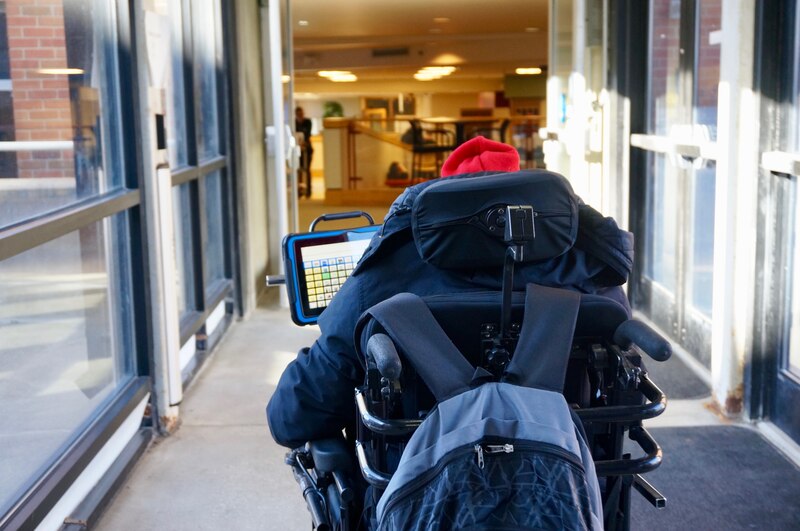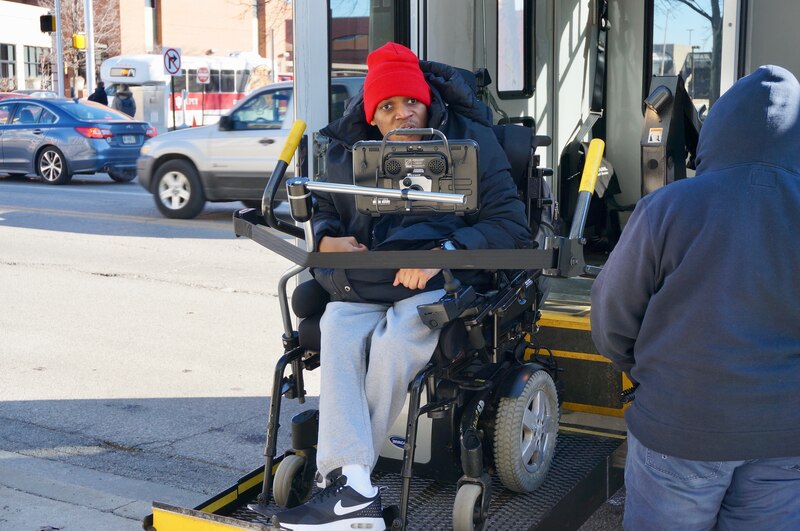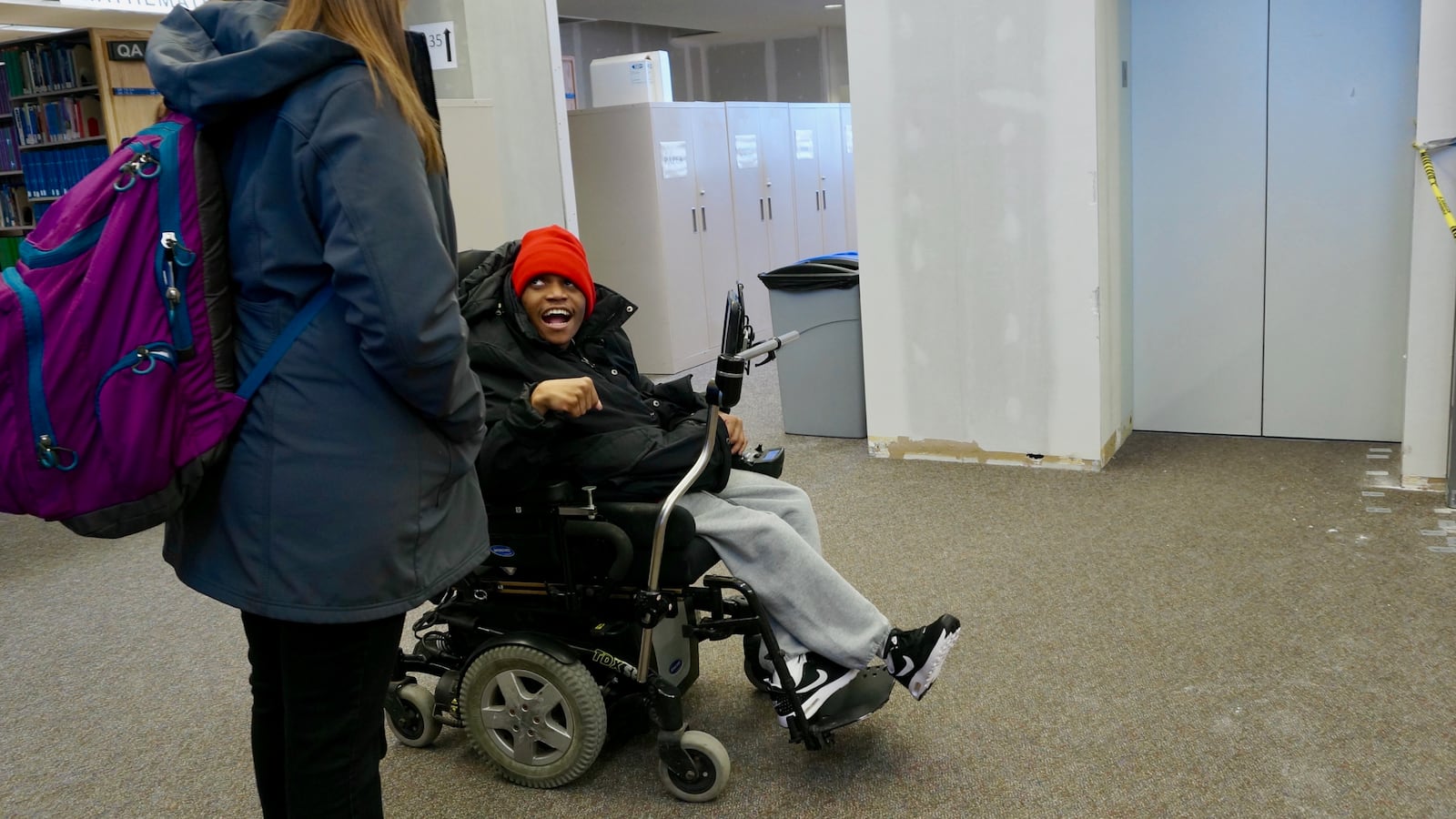On a typical day, Kaleb Sims leaves his house on the east side and gets on the city bus for the 20-minute trip to college. Along the way, he texts his teacher to say he’s on the way. On campus, he makes his way to class. When the day ends, he heads back home by bus.
For some students, that routine wouldn’t be notable. But for 21-year-old Sims, who is in a wheelchair and has limited speech because he has cerebral palsy, it’s a sign of his growing independence. His teachers say that taking the bus, texting, and navigating on his own are all skills that will be essential to help Sims thrive when he finishes school.
Sims is one of about 15 students in Project SITE, which is designed to prepare students with intellectual disabilities for life after school. The Indianapolis Public Schools program is run in partnership with Indiana University-Purdue University Indianapolis, where it is housed in the campus library.
Since he enrolled in July, Sims has gotten more comfortable with the campus and become more adept at communicating with a touchscreen, voice-output device mounted on his wheelchair, said his grandmother Mary Sims, who has raised him since he was a child.
“He’s learning independence,” she said. “He knows his surroundings. He knows people. He just loves it. And he also loves the teachers.”

Project SITE is aimed at students who have completed high school but are still eligible for special education services, which continue through age 21. Students stay for one to two years, during which time they work on mastering skills such as riding the bus, understanding who to ask for help, and even the basics of making social plans. They can also audit university classes such as yoga and Tai Chi.
It’s a rare opportunity for students who might not otherwise have a college experience. While the program costs about $18,545 per student, families aren’t charged, and much of that cost is covered by state and federal funding. Despite that support, the tiny program still costs Indianapolis Public Schools about $40,000 more than it receives in state and federal funding, according to the district.
On its own, that cost doesn’t make much of a dent in the district’s budget. But the price of services for students with disabilities quickly adds up, and officials say special education costs are one reason the district needs more money from taxpayers. Each year, Indianapolis Public Schools spends about $18 million more on special education than it receives from the state and federal government, according to the district.
Opened in 2006, the SITE program was an unusual offering when it began, said Pat Rogan, an IUPUI professor and a founder. In the years since, however, a movement has spread to create higher education options for students with intellectual disabilities. There are now more than 250 such college programs, including six in Indiana, according to Think College, a national organization based at the University of Massachusetts, Boston that supports higher education for people with intellectual disabilities.
“Too many students have been under lower expectations than they deserve,” Rogan said. “Our students always rise to the occasion.”
Students often spend the morning auditing IUPUI classes before heading to the library. There, they might meet with fellow SITE students for a club around an interest such as music or sports, before heading to another class, and, finally, to lunch. Once a day, they practice new bus routes to places like the doctor’s office or their favorite mall.
The program is open to families from outside of Indianapolis Public Schools, and there are students from as far away as Zionsville and Greenwood. In order to enroll, students need to have access to the bus system, because public transportation is essential to their independence as students and after they finish the program.

Because students with disabilities are eligible for special education through age 21, many remain in high schools for longer than the traditional 4 years. In high school life skills programs, students learn some of the same skills they do at SITE. But the context is fundamentally different.
“When you are in high school, a lot of times these self-contained classrooms, you are being told what to do and when to do and how to do and where to do it,” said Maggie Brown, a teacher in the program. At SITE, students have the independence to plan their own days. “It can be very intimidating to students,” she added.
For Kaleb Sims, leaving the familiar high school environment has helped push him to learn new skills. He uses his touchscreen device far more to communicate than he did in high school, said Laura Miller, who was his teacher high school and now teaches at SITE.
“People knew him well, and would anticipate his wants and needs,” Miller said. Now, “he’s taken on so much with his device,” she said. “He’s more certain of himself.”
Through his device, Sims can now handle basic logistics — such as making a call to ask Miller where to meet — and he can express himself in more personal ways. A country music lover, Sims can share his favorite song — “That’s my kind of night” by Luke Bryan. And on a Friday in February just days before the Super Bowl, Sims laughed as he shared his hopes for the downfall of the Patriots.
Since starting the program, “I am more confident and independent,” Sims said through the voice-output device. “I have made new friends.”
When students first enroll, they often need lots of hands-on help, but ultimately, teachers are focused on decreasing their support, so students can gain independence and transition as seamlessly as possible to adult life, said Gwen Chesterfield, a special education consultant who helped found the program.
“The goal of this program has always been to build a personally meaningful day for each student that we have in this program that will be sustained when they’re through with us,” she said. “That’s a big goal.”
Creating a worthwhile day will vary based on the student, but it might involve going to a local gym, meeting up with friends, or working. The aim is make sure students will be able to maintain a fulfilling life when they no longer receive the intensive services and support that is available at schools but not from adult services, said Chesterfield.
When Sims finishes SITE this year, he will head to another program that is focused on job training. Miller, who has taught him since high school, hopes that will be the next step in building a fulfilling adult life.
“I see him working a couple of days a week. I hope he’s getting together with friends a couple of days a week,” Miller said. “Everything that he wants to do is what I want for him.”

